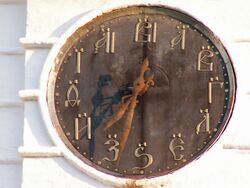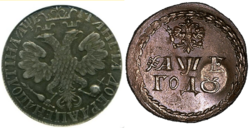Cyrillic numerals
 From HandWiki - Reading time: 5 min
From HandWiki - Reading time: 5 min
| Numeral systems |
|---|
 |
| Hindu–Arabic numeral system |
| East Asian |
| Alphabetic |
| Former |
| Positional systems by base |
| Non-standard positional numeral systems |
| List of numeral systems |
Cyrillic numerals are a numeral system derived from the Cyrillic script, developed in the First Bulgarian Empire in the late 10th century. It was used in the First Bulgarian Empire and by South and East Slavic peoples.[1] The system was used in Russia as late as the early 18th century, when Peter the Great replaced it with Arabic numerals as part of his civil script reform initiative.[2][3] Cyrillic numbers played a role in Peter the Great's currency reform plans, too, with silver wire kopecks issued after 1696 and mechanically minted coins issued between 1700 and 1722 inscribed with the date using Cyrillic numerals.[4] By 1725, Russian Imperial coins had transitioned to Arabic numerals.[5] The Cyrillic numerals may still be found in books written in the Church Slavonic language.[6]
General description
The system is a quasi-decimal alphabetic numeral system, equivalent to the Ionian numeral system but written with the corresponding graphemes of the Cyrillic script. The order is based on the original Greek alphabet rather than the standard Cyrillic alphabetical order.[7]
A separate letter is assigned to each unit (1, 2, ... 9), each multiple of ten (10, 20, ... 90), and each multiple of one hundred (100, 200, ... 900). To distinguish numbers from text, a titlo ( ҃) is sometimes drawn over the numbers, or they are set apart with dots.[8] The numbers are written as pronounced in Slavonic,[9] generally from the high value position to the low value position, with the exception of 11 through 19, which are written and pronounced with the ones unit before the tens; for example, ЗІ (17) is "семнадсять" (literally seven-on-ten, cf. the English seven-teen).[2]
Examples:
To evaluate a Cyrillic number, the values of all the figures are added up: for example, ѰЗ is 700 + 7, making 707. If the number is greater than 999 (ЦЧѲ), the thousands sign (҂) is used to multiply the number's value: for example, ҂Ѕ is 6000, while ҂Л҂В is parsed as 30,000 + 2000, making 32,000. To produce larger numbers, a modifying sign is used to encircle the number being multiplied.[10] Two scales existed in such cases (similar to the long and short scales): one is 'Малый счёт' or Lesser count giving a new name and sign /every order of magnitude/, and the other is 'Великий счёт' or Greater Count (both are squaring except for the end—extending to 10 in the 49th power).[11][12]
Table of values
|
|
|
- ^† In some varieties of Western Cyrillic, Ч was used for 60 and Ҁ was used for 90.
| Name (English)[11] | Lesser count multiplier | Greater count multiplier | Sign | Example |
|---|---|---|---|---|
| Тысяча знак (Thousand mark) | 1,000 | 1,000 | Template:Slavonic | |
| Тьма (Myriad) | 10,000 | 1,000,000 | Template:Slavonic | |
| Легион (Legion) | 100,000 | 1012 | Template:Slavonic | |
| Леодр (Legion of Legions) | 1,000,000 | 1024 | Template:Slavonic | |
| Вран (Ворон) (Raven/Crow) | 10,000,000 | 1048 | Template:Slavonic | |
| Колода (Trough/Log) | 100,000,000 | 1049 | Template:Slavonic | |
| Тьма тем (Many Myriad) | 1,000,000,000 | possibly 1050 | Template:Slavonic |
Computing codes
| character | ◌҃ | ◌︮ | ◌︦ | ◌︯ | ҂ | |||||
|---|---|---|---|---|---|---|---|---|---|---|
| Unicode name | COMBINING CYRILLIC TITLO |
COMBINING CYRILLIC TITLO LEFT HALF | COMBINING CONJOINING MACRON | COMBINING CYRILLIC TITLO RIGHT HALF | CYRILLIC THOUSANDS SIGN | |||||
| character encoding | decimal | hex | decimal | hex | decimal | hex | decimal | hex | decimal | hex |
| Unicode | 1155 | 0483 | 65070 | FE2E | 65062 | FE26 | 65071 | FE2F | 1154 | 0482 |
| UTF-8 | 210 131 | D2 83 | 239 184 174 | EF B8 AE | 239 184 166 | EF B8 A6 | 239 184 175 | EF B8 AF | 210 130 | D2 82 |
| Numeric character reference | ҃ | ҃ | ︮ | ︮ | ︦ | ︦ | ︯ | ︯ | ҂ | ҂ |
| character | ⃝ | ҈ | ҉ | ꙰ | ꙱ | ꙲ | ||||||
|---|---|---|---|---|---|---|---|---|---|---|---|---|
| Unicode name | COMBINING ENCLOSING CIRCLE (Cyrillic combining ten thousands sign) |
COMBINING CYRILLIC HUNDRED THOUSANDS SIGN |
COMBINING CYRILLIC MILLIONS SIGN |
COMBINING CYRILLIC TEN MILLIONS SIGN |
COMBINING CYRILLIC HUNDRED MILLIONS SIGN |
COMBINING CYRILLIC THOUSAND MILLIONS SIGN | ||||||
| character encoding | decimal | hex | decimal | hex | decimal | hex | decimal | hex | decimal | hex | decimal | hex |
| Unicode | 8413 | 20DD | 1160 | 0488 | 1161 | 0489 | 42608 | A670 | 42609 | A671 | 42610 | A672 |
| UTF-8 | 226 131 157 | E2 83 9D | 210 136 | D2 88 | 210 137 | D2 89 | 234 153 176 | EA 99 B0 | 234 153 177 | EA 99 B1 | 234 153 178 | EA 99 B2 |
| Numeric character reference | ⃝ | ⃝ | ҈ | ҈ | ҉ | ҉ | ꙰ | ꙰ | ꙱ | ꙱ | ꙲ | ꙲ |
See also
- Early Cyrillic alphabet
- Glagolitic alphabet
- Glagolitic numerals
- Greek numerals
- Relationship of Cyrillic and Glagolitic scripts
References
- ↑ Dejić, Mirko (2013). "How the old Slavs (Serbs) wrote numbers". BSHM Bulletin: Journal of the British Society for the History of Mathematics 29 (1): 2–17. doi:10.1080/17498430.2013.805559. ISSN 1749-8430.
- ↑ 2.0 2.1 Chrisomalis, Stephen (2010). Numerical Notation: A Comparative History. Cambridge, England: Cambridge University Press. pp. 180–182. ISBN 978-1-139-48533-3. https://books.google.com/books?id=kXZhBAAAQBAJ&pg=PA182. Retrieved 2016-12-28.
- ↑ Yefimov, Vladimir (2002), "Civil Type and Kis Cyrillic", in Berry, John D., Language Culture Type: International Type Design in the Age of Unicode, New York City: Graphis Press, pp. 369–147, ISBN 978-1932026016, http://typejournal.ru/en/articles/Civil-Type, retrieved 2017-01-02
- ↑ Teplyakov, Sergei (2011). "How To Identify & Interpret Cyrillic Dates on Russian Coins of Peter I The Great". Metal Detecting World. http://www.metaldetectingworld.com/russian_coins_peter_i.shtml.
- ↑ Lorković, Tatjana (2003). "Coins and Medals of Imperial Russia". Yale University Library. http://www.library.yale.edu/slavic/coins/peter1.html.
- ↑ Looijen, Maarten (2015) (in nl, en). Over Getallen Gesproken/Talking About Numbers (2nd ed.). Zaltbommel, Netherlands: Van Haren Publishing. pp. 59–60. ISBN 978-94-018-0601-5. https://books.google.com/books?id=k11dCwAAQBAJ&pg=PT62.
- ↑ Ager, Simon. "Omniglot: Cyrillic Script". http://www.omniglot.com/writing/cyrillic.htm.
- ↑ Gesang, Philipp (2013), Typesetting Cyrillic Numerals with ConTEXt MkIV, p. 3, http://mirror.hmc.edu/ctan/macros/context/contrib/context-cyrillicnumbers/doc/context/third/cyrillicnumbers/cyrillicnumbers.pdf, retrieved 2016-12-29
- ↑ Lunt, Horace Gray (2001). Old Church Slavonic Grammar (7th ed.). Berlin, Germany: Walter de Gruyter. pp. 16–18. ISBN 978-3-11-016284-4. https://books.google.com/books?id=7BXJgfIo_fYC&pg=PA16.
- ↑ Gamanovich, Alypy (2001). Shaw, John. ed. Grammar of the Church Slavonic Language. Jordanville, New York: Holy Trinity Monastery. ISBN 978-0884650645. https://books.google.com/books?id=5xxKAAAAYAAJ. Retrieved 2016-12-28.
- ↑ 11.0 11.1 Козловский, Станислав (2007-02-25). "У больших чисел громкие имена" (in ru). Вокруг Света (Moscow). http://www.vokrugsveta.ru/telegraph/theory/251/.
- ↑ "Slavic Paleography". Encyclopedia of Library and Information Science. 27. New York, NY: Marcel Dekker Inc.. 1979. pp. 510–520. ISBN 978-0-8247-2027-8. https://books.google.com/books?id=jU3fwyjqS5UC&pg=PA513. Retrieved 26 March 2018.
External links
 |
 KSF
KSF


